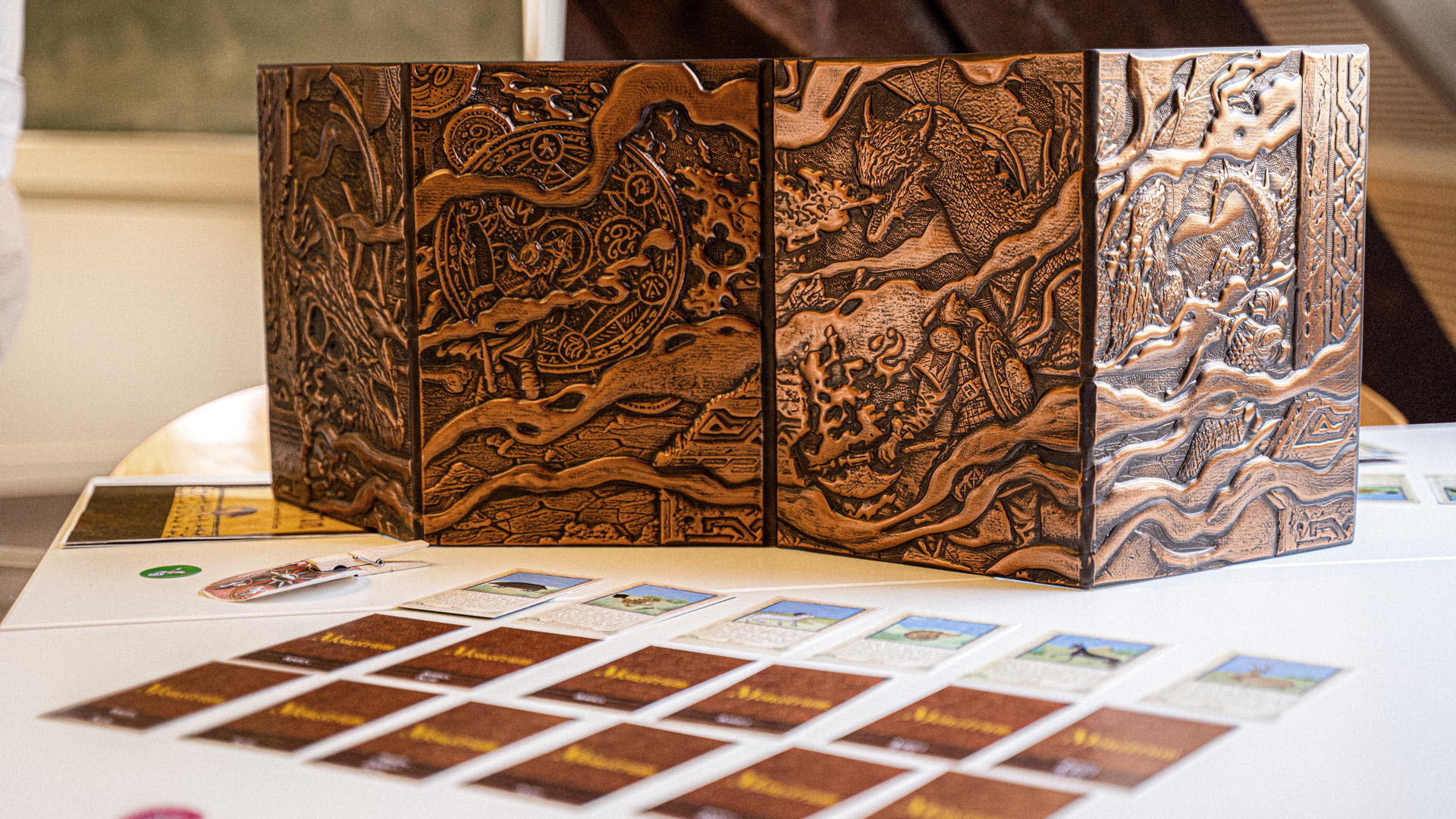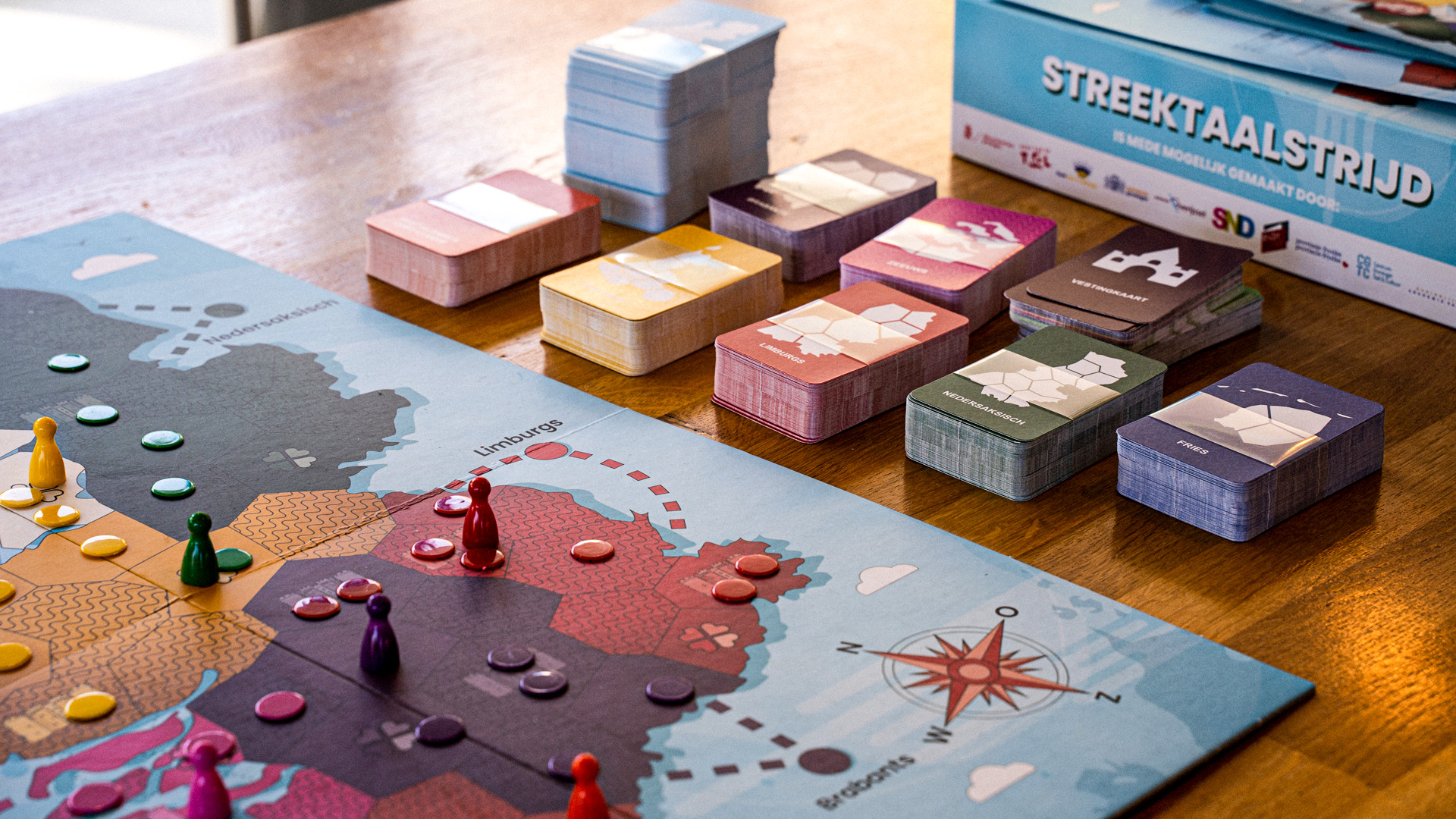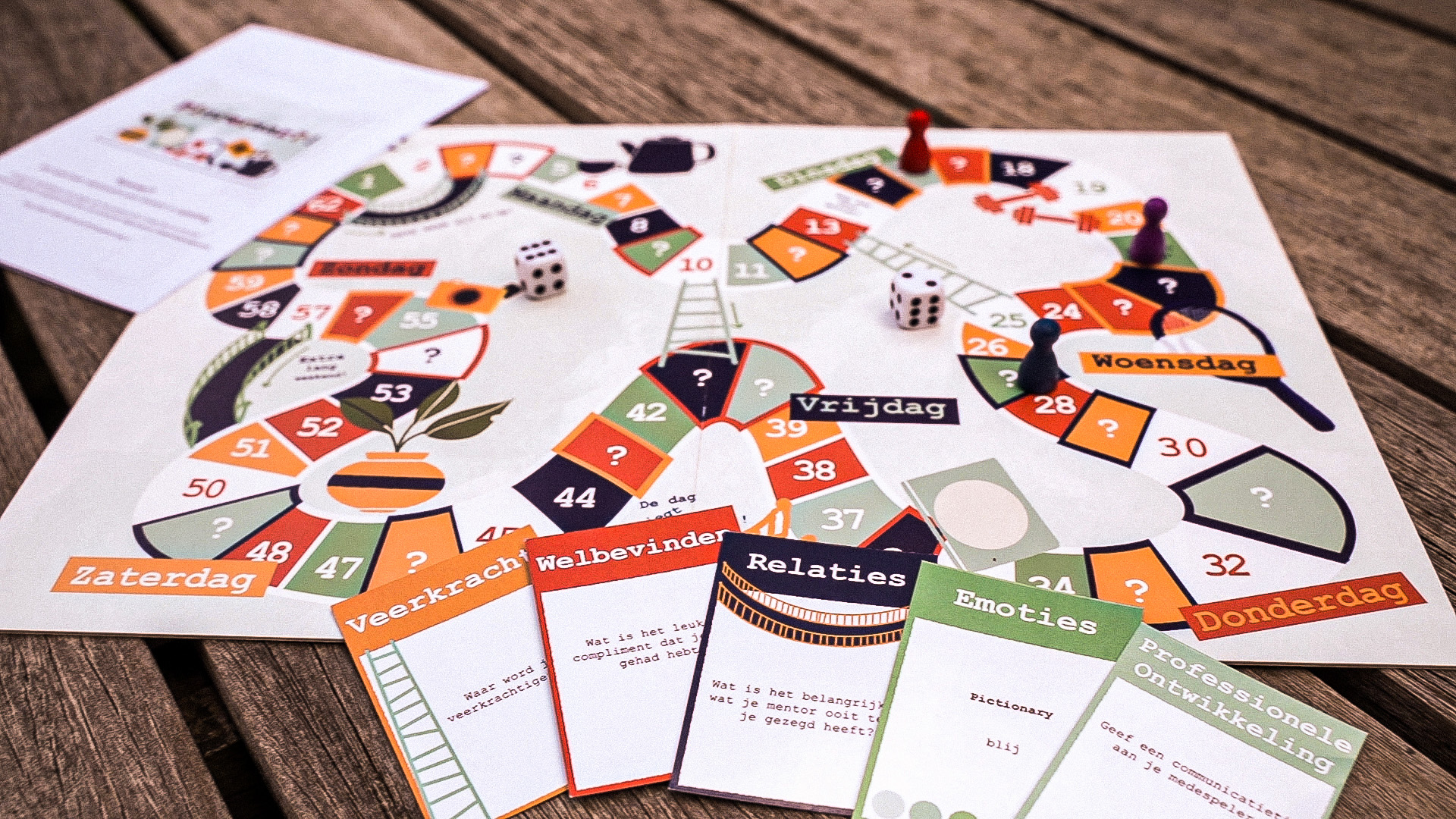Research becomes board game
Smarter in just a few throws
Sven Gins & Tamara de Bruin
Monstrum

For his research, Sven Gins, PhD student of mediaeval history and human-animal studies, looked through dozens of mediaeval bestiaries. ‘I noticed that the animals in those books had very associative descriptions’, he says. ‘They called spiders “air worms”, for instance.’
The books led to the idea of creating a board game as part of his PhD track. ‘I want to teach high school and university students how mediaeval people saw animals in a playful way and make them think about how we relate to animals today.’
Gins is a board game fanatic and regularly plays such games as Dixit, Simulo, OuiSi, and Mysterium. The latter involves players trying to figure out how a spirit died. ‘That’s a really associative game as well’, he says.
World view
He created Monstrum, where people have to guess the correct animal from a set of cards depicting real and imagined mediaeval animals. A mediaeval description of the animal helps players to find the right association. In the meantime, the players travel across a mediaeval map of the world. An animal is released on each continent for each correct answer.
This introduces the players to the Western mediaeval world view and mindset, Gins says. ‘One thing that’s striking is how the animals get weirder, wilder, and even more dangerous the farther away you get from “civilised” Europe.’
There’s one card that depicts ‘woman’ as a kind of beast
Part of this is made up. ‘The people who wrote these bestiaries hardly ever saw the animals in real life. They just copied earlier, often conflicting texts and drew their own conclusions.’ This led to the invention of fantastic animals, with human heads, rainbow colours, and sharp claws. They had equally strange names, such as ‘fig eater’ or ‘cathapleba’.
Some of the ideas people in the Middle Ages had are straight-up racist or sexist by today’s standards. ‘There’s one card that depicts “woman” as a kind of beast’, says Gins. ‘They genuinely thought they were back then. Women were this inferior being: argumentative, cruel, and only good for procreation.’ Project assistant Tamara de Bruin: ‘I hope that the game makes people think about things like that.’
Prototypes
Gins designed the first version of the game in his time off, testing it on his friends. The UG helped him get a grant that allows him to work on it for half a day each week. But he spends much more time on it, sometimes until the small hours of the morning.
Today, there are English and Dutch prototypes that can be tested on high school students and a wider audience. ‘The students are certainly enthusiastic, and they especially love all the weird animal facts’, says Gins. ‘They wanted more of those, and we realised we could tweak the games’ rules to be more accessible.’
He has a tip for anyone considering designing their own board game: ‘Play other games, or at least talk to game fanatics. Keep it simple: don’t try to cram every aspect of your research into a single game.’
Gins thinks it will be at least another year before the game will actually be on the market, in part because he’s still looking for additional funding. ‘At my PhD ceremony, I’d like to be able to tell people that after they heard all about my research, they can now play with it themselves.’
Hedwig Sekeres, Raoul Buurke & Lourens Visser
Streektaalstrijd

‘So can I buy your board game right now?’ people would ask linguists Lourens Visser, Raoul Buurke, and Hewig Sekeres when they presented their research at science festivals and events.
The three PhD students’ invention, Streektaalstrijd, based on a suggestion from their supervisor Martijn Wieling, quickly became a success. Wieling thought it might be a good idea to spend the funds they’d been given to tell a wider audience about their research on the game.
The game’s goal is to use coins to conquer ‘dialect areas’ on a map of the Netherlands and Flanders. Players earn these coins by answering questions on regional languages and fulfilling tasks. Because of this, the game resembles other games, like Risk and Trivial Pursuit.
Strategy
The first batch of five hundred games, which were delivered in February, sold out in ten days. ‘We honestly hadn’t expected that’, says Sekeres. They ordered a second batch totalling 2,500 games, of which there are still plenty available.
We want to destroy people’s preconceived notions about regional languages
You don’t have to be familiar with regional languages to play the game, says Sekeres. ‘If you employ a conquering strategy only you can still win.’ That’s because you’re occasionally allowed to place a coin on a region even if you answered the question incorrectly. If you do answer the question correctly, you can place two coins.
This was a tip from a game designer they involved early on, says Sekeres. ‘We wanted to make sure our design was solid. He said that without that rule it would become a very difficult game for people who weren’t interested in language.’
Sound fragments
Anyone who is a language fanatic can contribute to the game by recording sound fragments for special online cards, which get expanded all the time. ‘Players can listen to the fragments and guess where the dialect is from’, says Sekeres.
‘We approached people from some of the regions we had questions on’, says Visser. ‘Especially people in Zeeland were really enthusiastic’, says Sekeres. ‘The game got a lot of attention in the media, which is why they sent in a lot of questions.’
It did take a while before the game was finished. ‘We initially thought it would only take us a year, but it took us two and a half’, says Sekeres. ‘That’s probably a good tip for other people looking to design a game: make sure you have plenty of time. And make sure you test it often, including outside your target audience.’
‘We’d like to destroy people’s preconceived notions about regional languages with Streektaalstrijd’, says Visser. ‘Dialects aren’t wrong. In fact, what we know as standard Dutch is a dialect in and of itself.’
Streektaalstrijd is available for 37.50 at the UG’s webshop and in the shop in the Oude Kijk in ‘t Jatstraat.
Marjon Fokkens-Bruinsma
Floreraar

How can you teach teachers to deal with tensions at work? How can you make them more resilient and ensure fewer people in education calling in sick?
Associate professor of education Marjon Fokkens-Bruinsma came up with a solution: Floreraar. ‘Teacher trainers had expressed a need’, she says. ‘They wanted a casual way to broach the subject.’
Game of the Goose
Floreraar most closely resembles The Game of the Goose. Players throw a die and traverse the board. Along the way, they collect cards with questions such as ‘What does resilience mean to you?’ and ‘How do you maintain a friendship?’ The playing board has been divided into seven days. ‘After all, most teachers work seven days a week’, says Fokkens-Bruinsma.
The game can be played anywhere people are learning informally
Every participant needs to collect a card from each colour, which means they have to trade. ‘That makes it a truly cooperative game, since you can only win as a group.’
There are approximately fifty games left of the thousand that were originally manufactured. The rest has been given away at various places, ranging from conferences to workshops.
But the game isn’t just aimed at future teachers. ‘With just a few small adaptations, it can be played anywhere people are learning in an informal setting’, says Fokkens-Bruinsma. This takes place in many different fields, ranging from medicine to accountancy.
Student well-being
Fokkens-Bruinsma’s game has already been emulated. Lisa Kiltz used the board as inspiration for her own game, Campus Wellness quest. She works together with Fokkens-Bruinsma and is doing her PhD research on student well-being in higher education.
Kiltz, who is also an illustrator, designed the board herself and made different cards. ‘The goal is to make students aware of the three basic needs for their well-being: autonomy, competence, and connections’, she says.
Because she had a much smaller budget than Fokkens-Bruinsma, she was only able to create twenty-five games in total. She gave every single one away. ‘People who’d like to play the game can download and print their own version.’
Printing
But that’s not an ideal situation, says Kiltz. ‘You really have to start the process by asking yourself if there’s enough money to have the game professionally made. Having people print the game themselves isn’t great, to be honest.’
It’s still pretty popular, though. During the pandemic, the game was played quite often online at research universities and universities of applied sciences. ‘One of the students told me it makes a pretty difficult subject more accessible.’
You can request a copy of Floreraar by filling out a form here. You can download the files to play Campus Wellness Quest here.